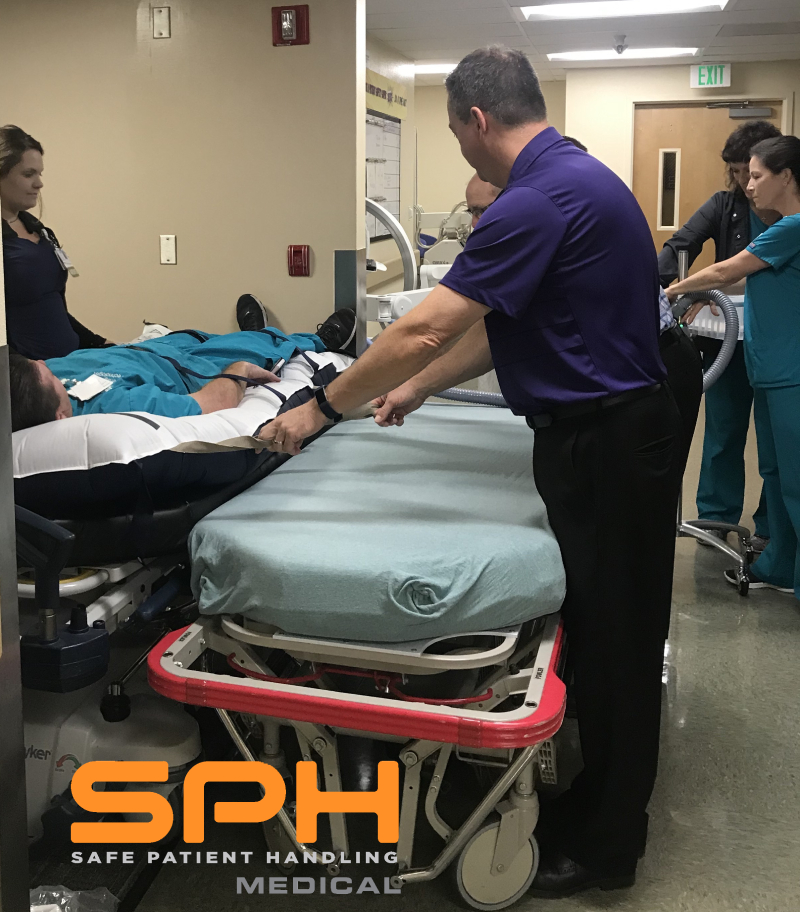Nurses Perform Transfers
It is a scenario that plays out in the hospital setting every day. A patient must move from a bed to a gurney for treatment or testing. Once the patient reaches his or her destination, it is time for another lateral transfer. SPH Medical is lowering the risk of nursing injury during lateral transfers.
When a patient is mobile, this is not too difficult. In many cases, nurses and other medical professionals have to move the full weight of the patient without any assistance. According to the American Nurses Association, the average nurse can transfer 1.8 tons during an eight-hour shift. As a result, the most common nursing injury complaint involves musculoskeletal damage. Nursing staff members are almost twice as likely to suffer from back injuries than employees in other industries.
Increased Risk to Nursing Injury
Two trends are making this problem even worse. First, fewer people are going into careers as nurses or nursing assistants. Second, American patients are getting heavier and come to the hospital with lower levels of mobility. The combination of these two developments means that fewer staff members may be trying to move more weight each day. In fact nurses are more likely to manually lift move or transfer a 300 pound patient with little to no assistance. In the construction world, a contractor would get a fork lift or the appropriate hoist to lift this much weight and both OSHA and their safety guidelines may require it!
For the medical staff, this extra effort leads to injuries of the lower back, neck and shoulders. These are not low frequency tasks. In 2017, nursing staff reported almost 20,000 musculoskeletal injuries that required days away from work or lost work days. For the health care industry, injuries lead to increased insurance claims, workers’ compensation costs, and a long list of indirect costs that affect staff morale, patient satisfaction and more.
Legislative Solutions to Reduce Nursing Injuries
In response to this situation, states like California and Washington have passed legislation to prevent workplace injuries in the health care field. These states make it a requirement that every hospital develops a plan for safe patient handling. In 2015, federal legislators introduced the Nurse and Health Care Worker Protection Act in both the House and Senate to make this a national policy. Unfortunately, they have not acted on the bill at this time.
The good news is that facilities that introduce comprehensive safety measures around patient handling and lateral transfer benefit from the program. While there is an up-front cost to the new equipment, there are long-term savings for the institution. An $800,000 safe lifting program implemented by Stanford University Medical Center resulted in a 2.2-million dollar savings over five years. They saw a drop in workers’ compensation claims as well as a lower incidence of pressure ulcers in patients with the resulting treatment costs. Members of SPH Medical’s team were involved with Stanford’s well recognized program from the very beginning.
The Benefits of Air-Assisted Lateral Transfer Systems
Historically, the the most common means to transfer patients from gurney to bed was by using a transfer sheet or plastic slide board. Both of these modalities can cause friction and put undue pressure on the patient and over exertion or physical strain on the medical staff. Thankfully, there are devices available that can ease this process for everyone involved and significantly reduce the risk of nursing injury.
At first glance, an air-assisted device like the Air Powered Lateral Transfer system looks like a regular air mattress. However, there is a fundamental difference. When inflated, air continually blows into the mattress. Small holes in the bottom create a layer of air that minimizes friction. According to the makers of the Hovermatt system, this air cushion reduces the force required to move a patient by 80 to 90 percent and greatly reduces the risk of a nursing injury. A task that needed four medical staff members can be done safely by two.
Because the system can sit underneath a patient at all times, it will also reduce the risk of a repositioning injury. Nursing staff frequently must boost up a patient who has slipped down in his or her bed. An air-assisted transfer system makes this a stress-free task.
Using an air-assisted transfer system is beneficial to overall patient care. Transfers are faster and safer. These qualities matter when a patient is dealing with pain. Minimizing unnecessary motion keeps patients more comfortable.
SPH Medical specializes in equipment to promote handling patients safely and efficiently. Incorporating air powered lateral transfer solutions will benefit patients, staff and the entire medical organization by reducing costs, improving efficiencies, and most importantly improving patient care and patient satisfaction. Contact SPH Medical today to reduce nursing injuries in your facility.

